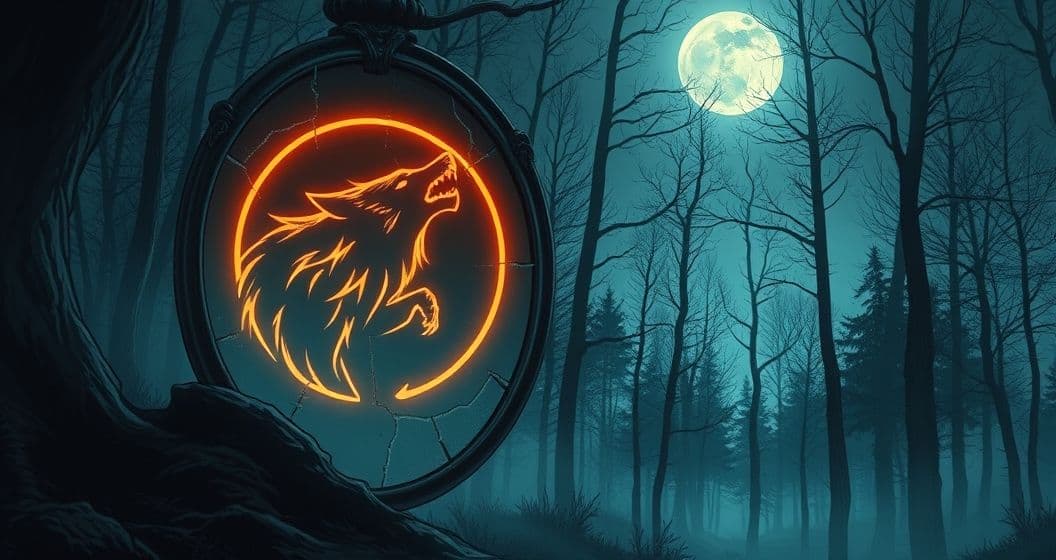Core Symbols: The Werewolf Sigil and Mirror in Dreamspace
A werewolf sigil in dreams is rarely random—it’s a personal emblem etched into the subconscious, often signifying a primal threshold. Unlike generic wolf symbols, sigils here carry intentionality, marking a boundary between the conscious self and the 'inner beast'—that part of you that craves freedom, authenticity, or rebellion against constraints. Imagine a sigil: maybe it’s a snarling wolf’s head with glowing eyes, or a clawed handprint tracing a crescent moon. These aren’t just images; they’re emotional signposts pointing to repressed energy—anger, passion, or untapped potential you’ve been ignoring.
Mirrors in dreams, meanwhile, rarely reflect literal appearances. When paired with werewolf imagery, they become portals to self-confrontation. A clear mirror might show your true self beneath social masks; a cracked or foggy one could signal inner conflict. The werewolf mirror often reveals a distorted reflection: the 'you' you want to be (bold, untamed) versus the 'you' you’ve become (caged, conforming). Together, sigil and mirror create a dialogue: the sigil demands attention, the mirror forces you to look.
Psychology Lens: Jung, Freud, and the Primal Unconscious
Want a More Personalized Interpretation?
Get your own AI-powered dream analysis tailored specifically to your dream
🔮Try Dream Analysis FreeCarl Jung’s shadow archetype offers a key here. The werewolf represents the shadow—those parts of yourself you’ve disowned, yet they persist, like an unruly guest in your psyche. Unlike Freud’s focus on repressed sexual urges, Jung saw the shadow as a source of wholeness; integrating it isn’t about taming the beast but understanding its language. A werewolf sigil dream might be your shadow knocking, demanding recognition.
Neuroscience adds another layer: REM sleep, when most vivid dreams occur, processes emotional memories. If you’ve recently faced a decision (career, relationship, identity), your brain might use werewolf imagery to work through the tension of change. The 'beast' isn’t evil—it’s your brain’s way of processing fear of the unknown, using primal symbols to make abstract emotions concrete.
Culturally, werewolves span myths: in Greek lore, Lycaon’s curse stemmed from hubris, a warning against denying your true nature. In Native American traditions, the wolf totem is a guide, teaching intuition and community. Your dream’s werewolf isn’t just a monster—it’s a cultural echo, reminding you to honor both your civilized and wild sides.
Life Triggers: When the Beast Awakens
These dreams rarely emerge without context. Career stagnation often triggers werewolf sigils: you feel caged by routine, your inner fire suppressed. A job change, promotion, or even a new project might stir the 'werewolf energy'—the need to break free and howl at the moon of your potential.
Relationships, too, can spark these dreams. If you’re in a partnership that feels inauthentic, the werewolf mirror might show you the 'you' you’ve lost, while the sigil urges you to reclaim your voice. A recent breakup or shift in friendship dynamics can also activate this imagery, as your subconscious processes the loss of a familiar identity.
Midlife transitions are another trigger. The werewolf, with its liminal nature (neither fully human nor beast), speaks to the 'in-between' phase: questioning purpose, redefining success, or confronting mortality. The mirror reflects not just your physical self but the version of you you’re still becoming.
What To Do Next: From Dream to Daily Life
Start with short-term reflection: Grab your journal and ask, What did the sigil look like? Was it fierce, gentle, or broken? How did the mirror feel? Cold, warm, or distorted? These details aren’t random—they’re your subconscious’s way of labeling emotions. Note the emotions: fear, exhilaration, or longing? Emotions are the bridge between dream and reality.
Medium-term experimentation: Create a 'sigil ritual.' Draw the sigil you saw in your dream, then burn or bury it (symbolic release). If the mirror felt distorted, try a 'truth mirror' exercise: each morning, write one thing you’ve been hiding about yourself, then place it in front of a mirror. This practice helps integrate the shadow by naming it.
Long-term integration: Notice patterns in your waking life. Do you avoid certain spaces, people, or tasks? The werewolf might be urging you to confront those. Try small acts of rebellion: take a new route home, speak up in a meeting, or dance wildly to a song you love. These 'howling moments' train your brain to embrace the untamed self.
FAQ: Answering Common Questions
Q: What does a werewolf sigil in dreams mean if I feel empowered, not afraid?
A: Empowerment is a sign of integration! The sigil here signals you’re recognizing your inner strength, not fearing it. It’s a call to act on that power, not suppress it.
Q: Why do I keep dreaming of a werewolf mirror that shows me as both human and wolf?
A: This duality reflects your journey of self-acceptance—you’re learning to honor both your softness and boldness. The mirror shows progress, not failure; keep nurturing that balance.
Q: Can these dreams predict future events?
A: No, they’re more about internal processing. The werewolf isn’t a prophecy—it’s a prompt to address what’s alive in your heart now, before external events demand change.
